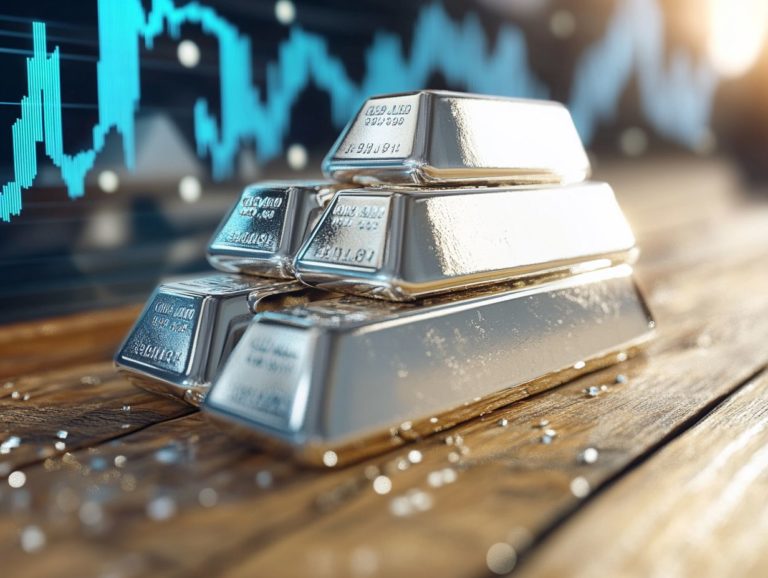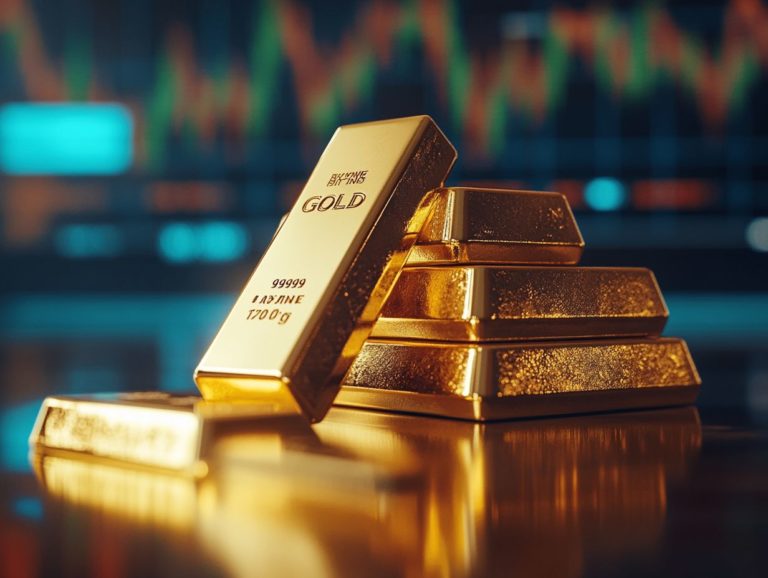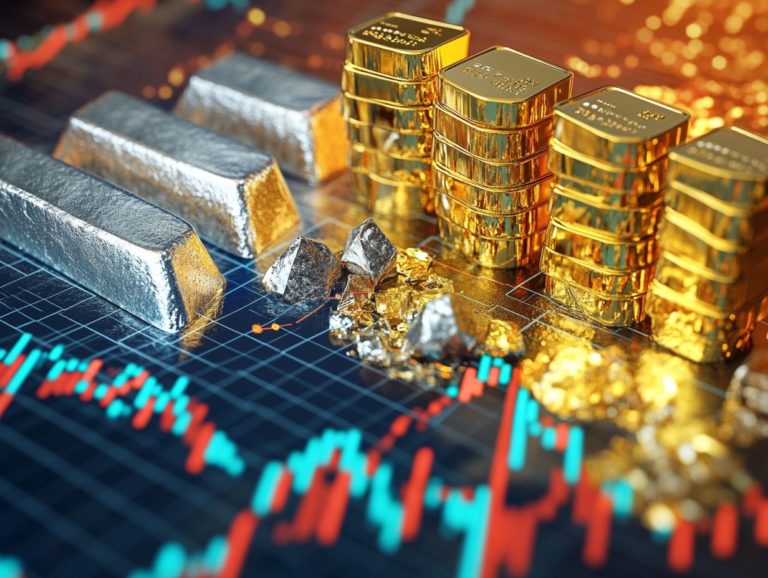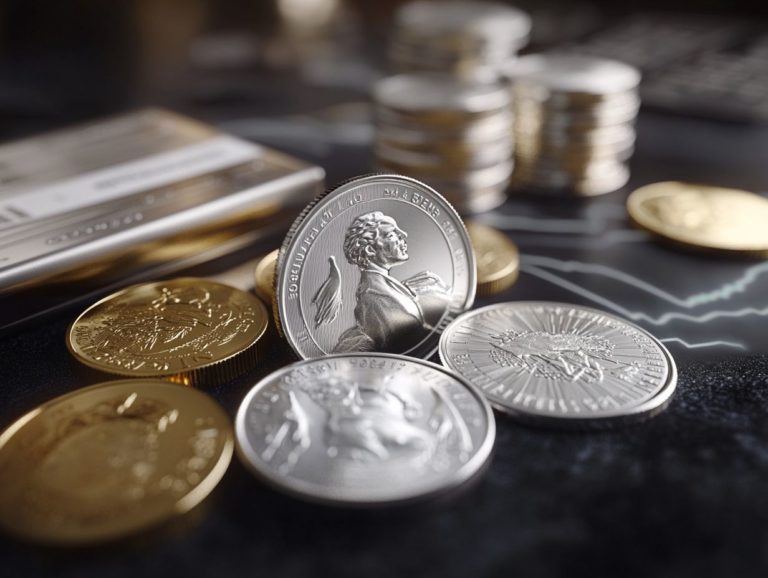The Impact of Inflation on Gold Investments
Inflation is a complex economic issue that significantly impacts your purchasing power. It also influences your investment strategies. As prices climb, you might find yourself seeking refuge in assets that can endure economic turbulence.
This article explores the definition of inflation and its effects on various investments. We ll also discuss why gold often emerges as a favored choice during these challenging times.
You ll discover essential factors to consider when investing in gold, along with alternatives that can provide inflation resistance.
Together, we ll navigate this vital topic that holds great importance for today s investors.
Contents
- Key Takeaways:
- Understanding Inflation and Its Effects
- Why Gold is a Popular Investment During Inflation
- Factors to Consider When Investing in Gold During Inflation
- Alternatives to Investing in Gold During Inflation
- Frequently Asked Questions
- What is inflation and how does it impact gold investments?
- How does gold act as a hedge against inflation?
- Are there any risks associated with investing in gold during inflation?
- How does the rate of inflation affect gold investments?
- Is investing in physical gold the only way to protect against inflation?
- How can I determine the best time to invest in gold during inflation?
Key Takeaways:
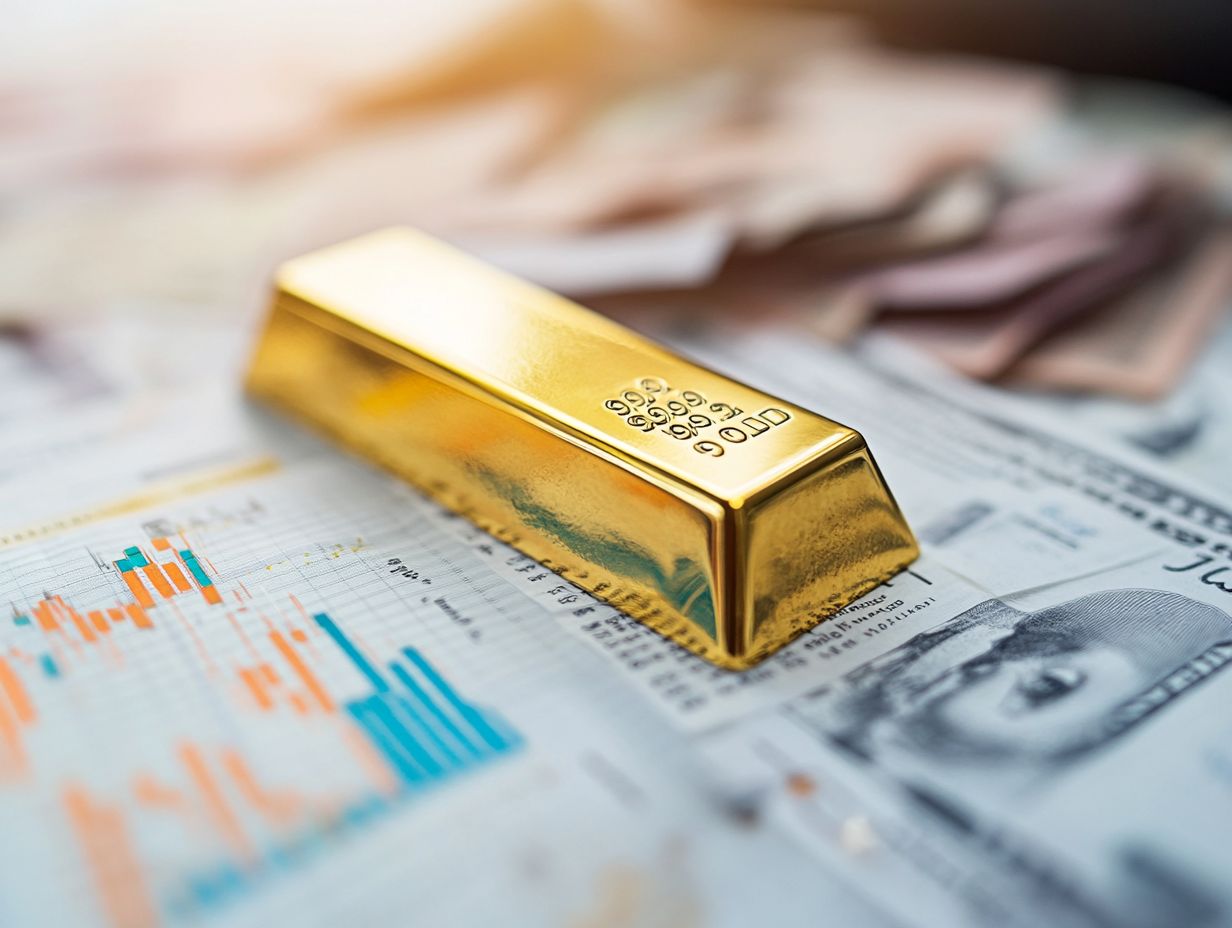
- Gold is a popular investment during inflation due to its historical performance and unique qualities as an inflation hedge.
- Timing, market trends, and risk management are important factors to consider when investing in gold during inflation.
- While gold is a popular option, there are alternative inflation-resistant assets to consider, each with their own pros and cons.
Understanding Inflation and Its Effects
Inflation is an economic phenomenon marked by a general rise in prices over time. This inevitably diminishes the purchasing power of money, profoundly impacting various sectors, including investments and consumer behavior.
To truly grasp inflation, you must analyze its causes. These include increases in the money supply and factors that increase demand. Understanding how inflation shifts market dynamics can prevent crises for investors.
The Consumer Price Index (CPI) is a key indicator that reflects changes in the cost of living. It plays a crucial role in shaping monetary policy.
What is Inflation?
Inflation signals a general uptick in the prices of goods and services over a defined timeframe. This rise profoundly affects your purchasing power and the overall economy.
Economists categorize inflation into two primary types: demand-pull and cost-push inflation. Demand-pull inflation occurs when demand for goods and services exceeds supply. This often happens during economic growth phases, resulting in higher prices. Think about bustling holiday seasons when consumer spending surges.
Conversely, cost-push inflation arises from escalating production costs, such as raw materials or wages. Companies often pass these expenses onto consumers, directly impacting your household budget and lifestyle choices. Understanding these dynamics is essential for making savvy financial decisions.
How Inflation Affects Investments
Inflation significantly impacts your investments by eroding the real returns on your assets. This prompts you to seek more resilient options within your portfolio.
As prices rise, your money’s purchasing power diminishes. This may lead you to reevaluate your investment strategies. Historically, stocks have provided better long-term protection against inflation due to their potential for earnings growth.
In contrast, bonds often lose value as interest rates increase in response to inflationary pressures. Commodities, however, frequently serve as a hedge against inflation thanks to their intrinsic value.
To navigate this complex landscape, consider diversifying your holdings. Incorporate inflation-linked bonds and allocate a portion of your portfolio to commodities. This balanced approach can help safeguard against the unpredictable nature of inflation, allowing for more stable long-term growth.
Why Gold is a Popular Investment During Inflation
Gold consistently stands out as a favored investment during inflationary periods. Its esteemed status as a safe-haven asset makes it a dependable store of value. It effectively serves as a hedge against the erosive effects of inflation on purchasing power.
You might be drawn to gold primarily due to its limited supply, which helps maintain its value when other assets struggle under inflationary strains. Historically, gold’s resilience during economic crises attracts those seeking both portfolio diversification and a safeguard against market volatility.
Understanding inflation now can protect your future investments!
Historical Performance of Gold During Inflationary Periods
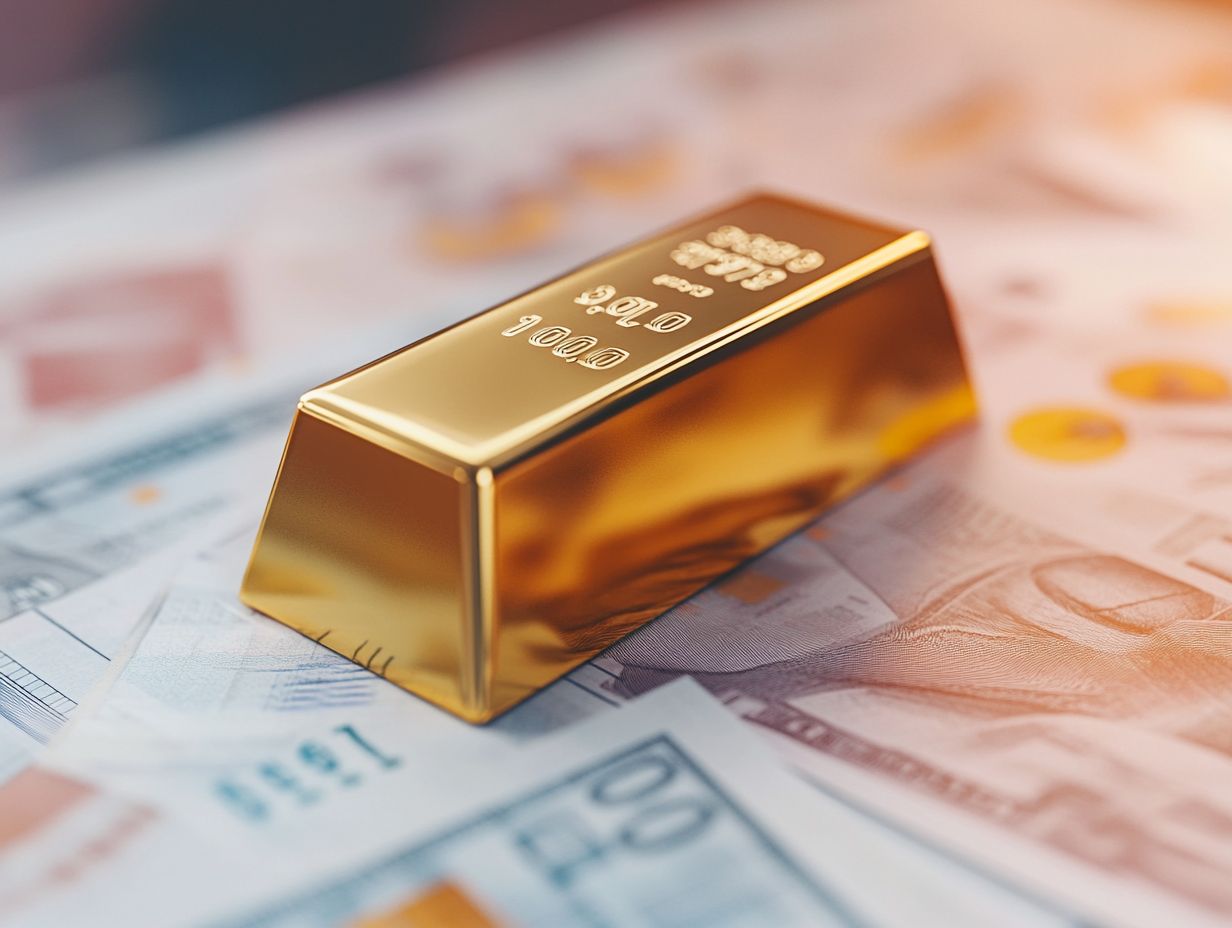
Historically, gold has consistently performed well during inflationary periods. It often outshines other asset classes, attracting investors searching for stability.
This trend has been especially pronounced during significant economic upheavals, like the Great Recession from 2007 to 2009 and the new problems caused by the Covid-19 pandemic. During the Great Recession, gold prices skyrocketed from around $600 to nearly $1,900 per ounce by 2011, showcasing its appeal as a safe-haven asset during financial chaos.
After the onset of the pandemic, gold prices soared to new heights, surpassing $2,000 per ounce in August 2020, as investors scrambled for shelter from market volatility and economic uncertainty.
Charts from these periods illustrate a consistent correlation between rising inflation rates and gold’s upward trajectory. This emphasizes its vital role as a hedge against economic instability.
Unique Qualities of Gold as an Inflation Hedge
Gold possesses unique qualities that make it an effective hedge against inflation. It serves as a safe-haven asset and a durable store of value.
This precious metal has captured admiration across civilizations throughout history, from the ancient Egyptians, who adorned their tombs with gold artifacts, to the Incas, who revered it as the sweat of the sun. Its limited supply, marked by challenging mining processes and finite reserves, enhances its allure as a resource that can t be easily replicated unlike fiat currencies.
As a result, gold is a thrilling option for diversifying your investment portfolio, especially during tough times! It tends to maintain its value even in turbulent economic conditions. Additionally, it’s important to consider gold’s tax implications, as these intrinsic properties not only bolster gold’s status as a financial safeguard but also reaffirm its enduring significance in the global investment landscape.
Factors to Consider When Investing in Gold During Inflation
When considering investing in gold during inflationary periods, it’s essential to weigh several critical factors, including timing and current market trends. Recognizing the importance of diversification and effective risk management strategies is also vital.
As you assess economic indicators, like the Consumer Price Index (CPI) a measure that examines the average change over time in the prices paid by consumers for goods and services and market volatility, seize the moment! Identify the best times to invest in gold and capitalize on market shifts.
Incorporating gold into a diversified portfolio helps reduce the risks associated with inflation. This allows you to maintain a balanced approach to your long-term financial security.
Timing and Market Trends
Timing and understanding market trends are essential for investors looking to capitalize on gold during inflationary periods.
By closely monitoring economic indicators, such as changes in the Consumer Price Index (CPI) and interest rate shifts, you can make informed decisions about when to enter or exit positions in the gold market. Utilizing tools like technical analysis charts and economic calendars provides valuable insights into upcoming trends, allowing for more strategic timing.
Moreover, tapping into resources such as reputable financial news outlets or investment platforms focused on commodities can deepen your understanding of how fluctuations in gold prices often reflect broader economic movements, especially during rising inflation. Additionally, recognizing the importance of tax strategies for gold investors can significantly enhance your investment outcomes.
Diversification and Risk Management
Diversification and effective risk management are vital components for anyone considering incorporating gold into their investment strategy during inflationary periods.
By blending gold with a variety of asset classes, you can reduce exposure to market volatility while positioning your portfolio for potential growth. Gold is often seen as a safe haven. Its unique characteristics provide a valuable cushion against currency fluctuations and economic downturns.
This thoughtful inclusion smooths out your returns and fosters a balanced approach to preserving your wealth.
Utilizing strategies such as regularly adjusting your investments and investing a fixed amount regularly can further enhance your risk management efficiency. This ensures your investments align with your individual risk tolerance and the prevailing market conditions.
Alternatives to Investing in Gold During Inflation

As an investor exploring alternatives to gold in inflationary times, you have a range of inflation-resistant assets at your disposal. Each option comes with its own performance metrics and risks, allowing you to choose the path that best aligns with your financial strategy.
Other Inflation-Resistant Assets
Several inflation-resistant assets, including real estate, commodities, and Bitcoin, present viable alternatives for those looking to protect their portfolio.
These asset classes act as effective hedges against the erosive effects of rising prices, each offering unique benefits. For instance, real estate often appreciates over time, providing not only rental income but also the potential for capital gains. This makes it a favored choice during inflationary periods.
Commodities, such as oil and agricultural products, tend to increase in value when inflation hits, reflecting rising input costs and heightened demand. Then there’s Bitcoin, known for its decentralized nature, which introduces a modern avenue for inflation protection and appeals to those seeking diversification.
Explore these exciting options! You may find them even more attractive than gold, which, although historically viewed as a safe haven, has its own set of challenges in volatile markets.
Pros and Cons of Each Option
Each alternative to gold presents its own set of advantages and disadvantages that require careful evaluation, keeping your investment goals and risk tolerance in mind.
When considering assets such as real estate, cryptocurrencies, or commodities, it s essential to assess not only their potential for appreciation but also their volatility and liquidity.
Volatility refers to how much the price of an asset can change. Liquidity means how easily you can buy or sell an asset.
For example, while real estate can offer stable returns and income through rental yields, it often comes with high initial costs and ongoing maintenance. In contrast, cryptocurrencies promise remarkable upside potential, but their notoriously erratic prices can make them quite risky.
By grasping these dynamics and conducting thorough research on inflation-resistant assets, you can navigate your investment choices more effectively and tailor your portfolio to align with your unique financial strategies.
Frequently Asked Questions
What is inflation and how does it impact gold investments?
Inflation is a general increase in the price of goods and services, resulting in a decrease in the purchasing power of currency. As the value of currency decreases, the value of gold typically increases, making it a popular investment during times of inflation.
How does gold act as a hedge against inflation?
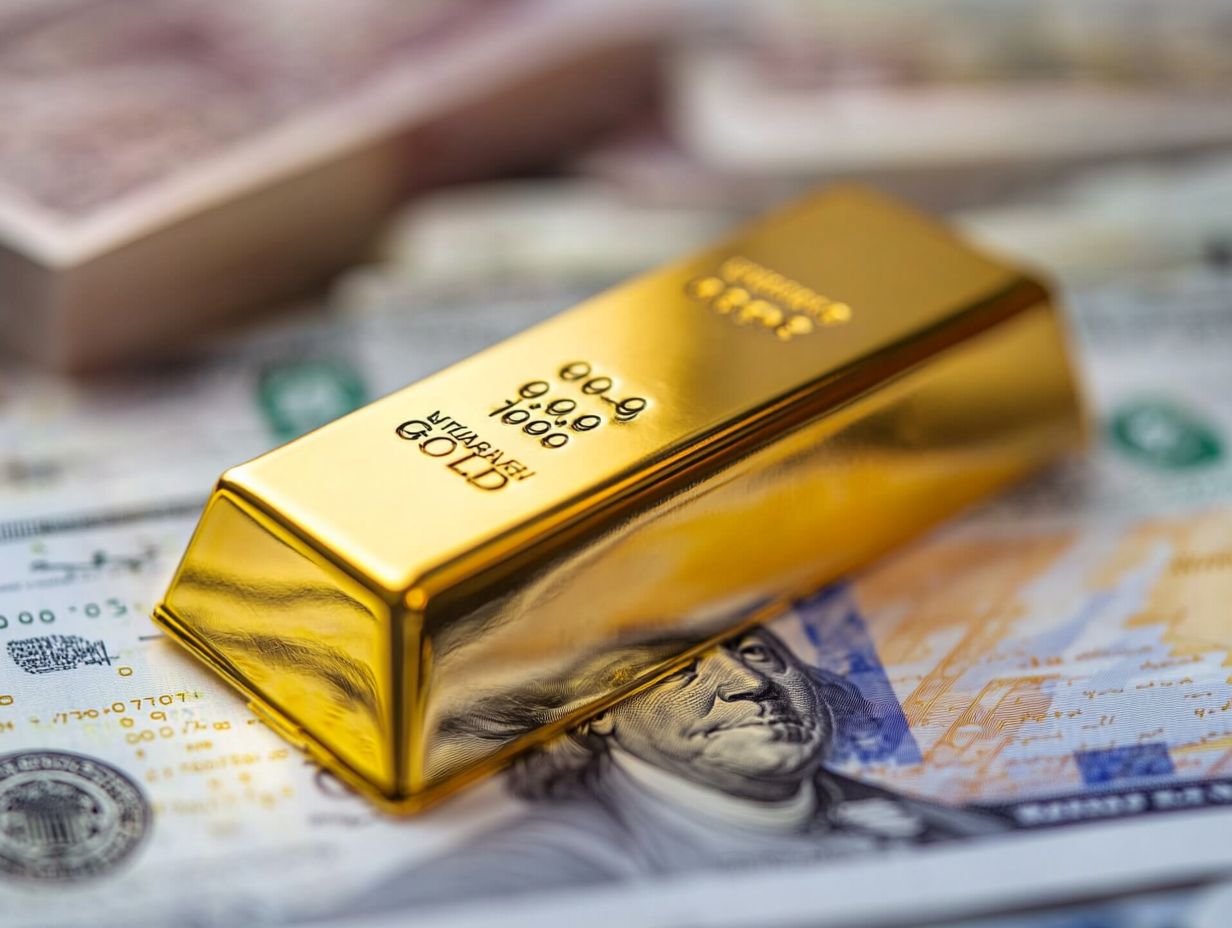
Gold is often seen as a safe haven during times of economic uncertainty and inflation. It tends to hold its value better than other investments. This is because the supply of gold is limited, making it a scarce resource that retains its value even during periods of inflation.
Are there any risks associated with investing in gold during inflation?
Gold is often seen as a safe investment during inflation, but it does come with risks. The price of gold can change frequently. If investors buy gold when prices are high, they might lose money if prices drop later.
How does the rate of inflation affect gold investments?
The inflation rate can greatly impact gold investments. When inflation rises, demand for gold usually increases, driving up its price.
However, if inflation is low, demand for gold may fall, which can lead to a decrease in its value.
Is investing in physical gold the only way to protect against inflation?
No, you can also invest in gold in other ways. For example, you can buy gold Exchange-Traded Funds (ETFs) or gold mining stocks. These options can be more convenient and cost-effective during inflation.
How can I determine the best time to invest in gold during inflation?
While we can’t predict the future, we can use some smart strategies! Monitoring key economic numbers can help you make better decisions about when to invest in gold.
Consulting with a financial advisor can also provide valuable insights!










